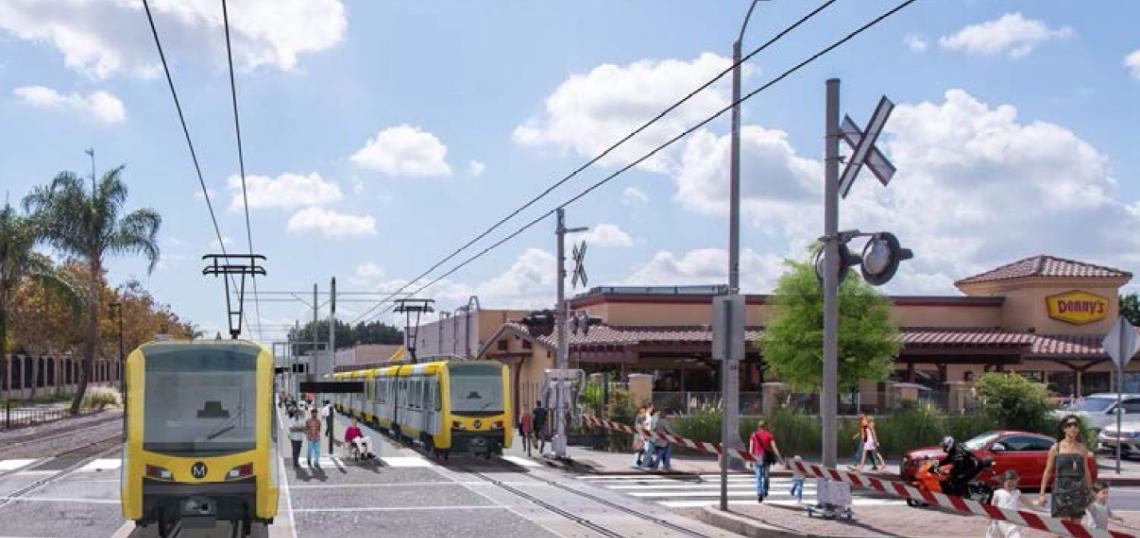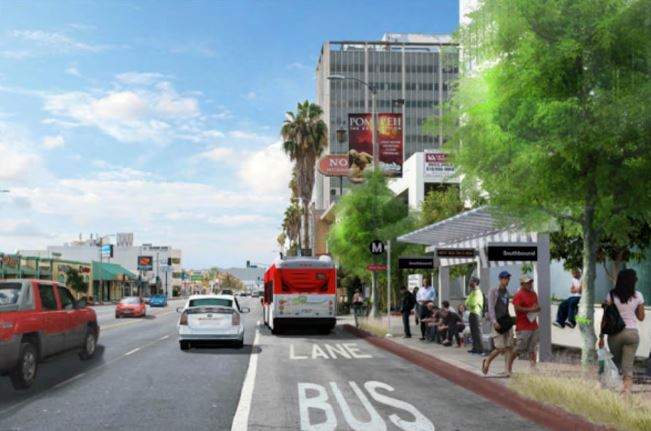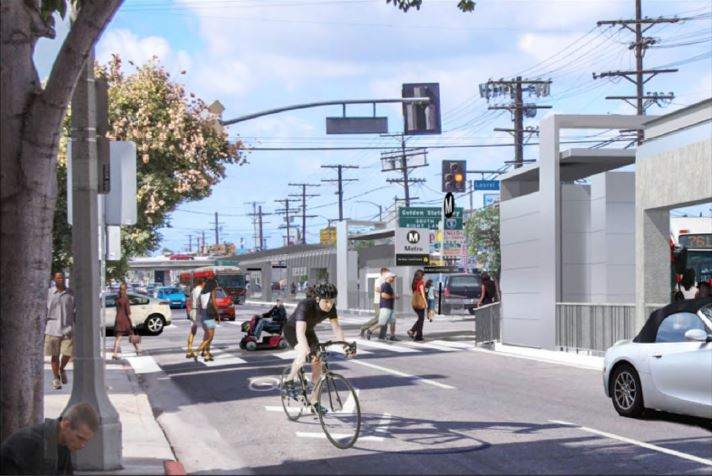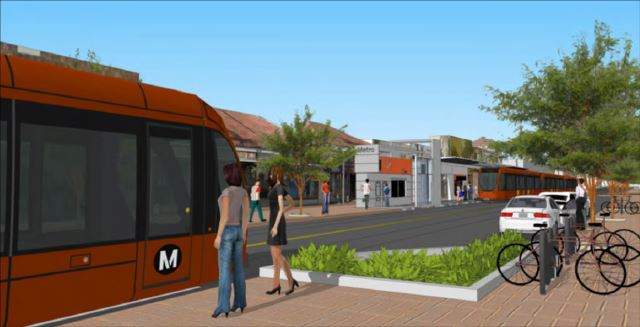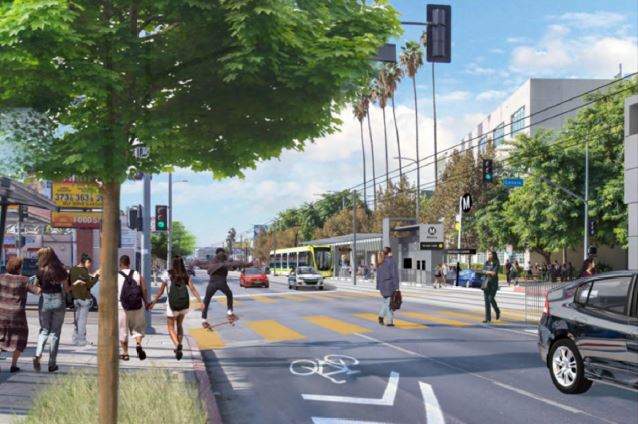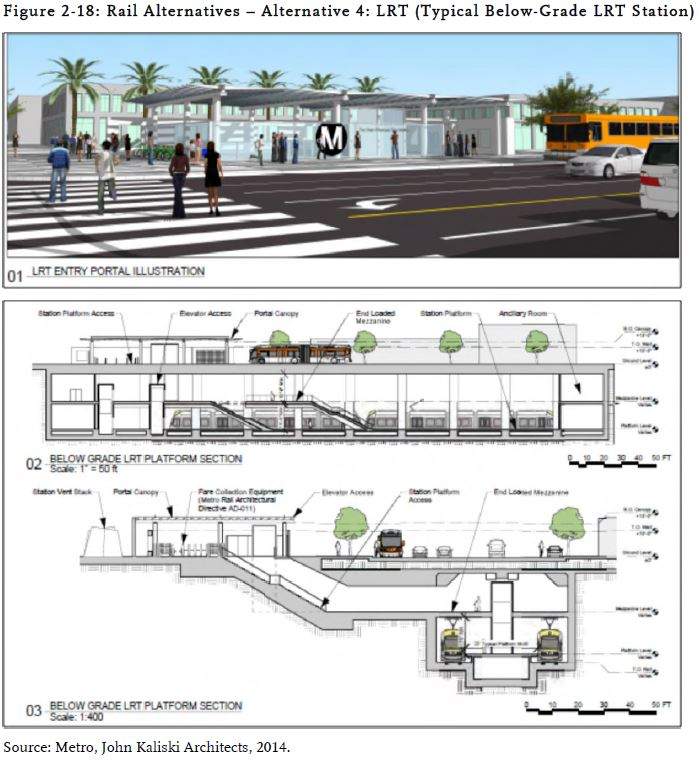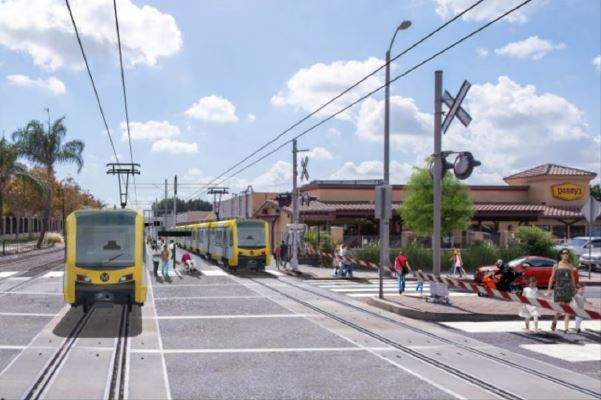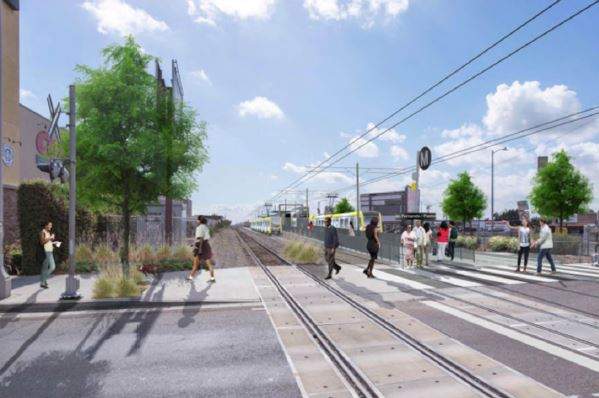Metro has released a draft environmental impact report for the East San Fernando Valley Transit Corridor (ESFVTC), a project with funding from Measures R and M that could bring a bus rapid transit or light rail line to the Van Nuys corridor.
The ESFVTC spans approximately 9.2 miles, starting at the Sylmar Metrolink station in the north and terminating at the Van Nuys Orange Line bus station in the south. As of 2010, the immediate surroundings of the transit corridor was found to be home to over 167,000 people in 2010, out of the approximately 458,000 people living in the larger study area. Employment within this section of the San Fernando Valley totaled 141,000 as of 2010, with approximatley 30 percent of those jobs in the immediate vicinity of the transit corridor.
To serve this population, Metro is studying a variety of transit modes, including curb-running bus rapid transit, median-running bus rapid transit, low-floor light rail and traditional light rail transit.
Curb-Running BRT
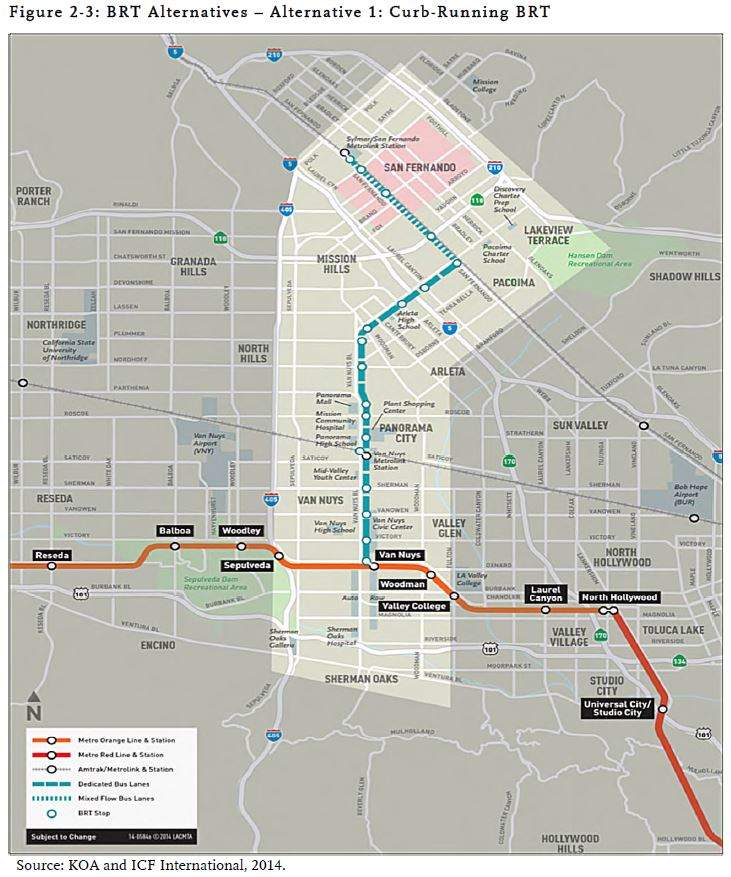
Under the curb-running bus rapid transit alternative, Metro Rapid Line 761X would operate in mixed-flow traffic between the Sylmar/San Fernando Metrolink Station and Van Nuys Boulevard. At that point, service would turn south onto Van Nuys and travel on dedicated bus lanes until reaching the Orange Line busway, after which point it would return to mixed-flow traffic.
A total of 18 stops are proposed at major streets and transit hubs, such as the Van Nuys Metrolink Station and the Orange Line.
Service would run at six-minute intervals during peak hours, and 12-minute headways during off-peak hours. Travel times would be improved by 15-to-18 percent through the curb-running alternative, or approximately 41 minutes from end-to-end.
Curb-running bus rapid transit is budgeted at approximately $294 million, and would carry approximatley 30,900 daily passengers by 2040.
Median-Running BRT
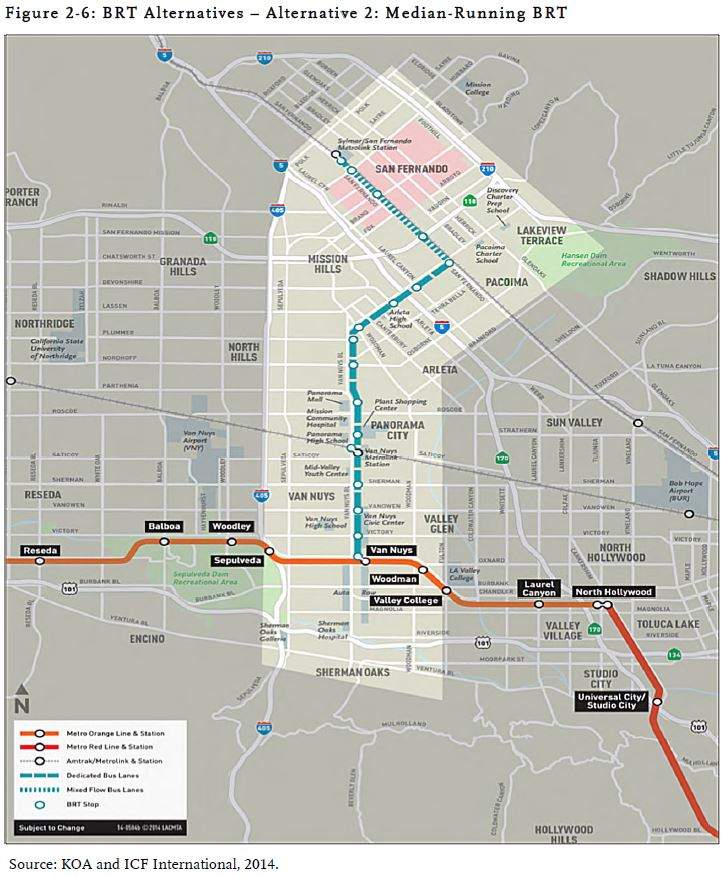
The median-running bus rapit transit alternative would include 6.7 miles of dedicated median bus lanes between San Fernando Road and the Orange Line, with similar operational standards to the Orange Line. Existing asphalt lanes would be stripped and replaced with concrete on Van Nuys Boulevard. Mixed-traffic operations would remain on the 2.5 miles between the Sylmar/San Fernando Metrolink Station and Van Nuys Boulevard.
This alternative would include 17 stops, utilizing existing bus stations along San Fernando Road and center-median stations on major intersections along Van Nuys Bouleard.
Buses would run at 6-minute intervals at peak headways, and 12-minute intervals on off-peak hours. Like the curb-running alternative, travel times would be improved by 15-to-18 percent by center-median operations, or 37 minutes from end-to-end.
Median-running bus rapid transit carries an estimated cost of $402 million, and would carry an estimated 31,500 daily passengers by the year 2040.
Low-Floor LRT/Tram
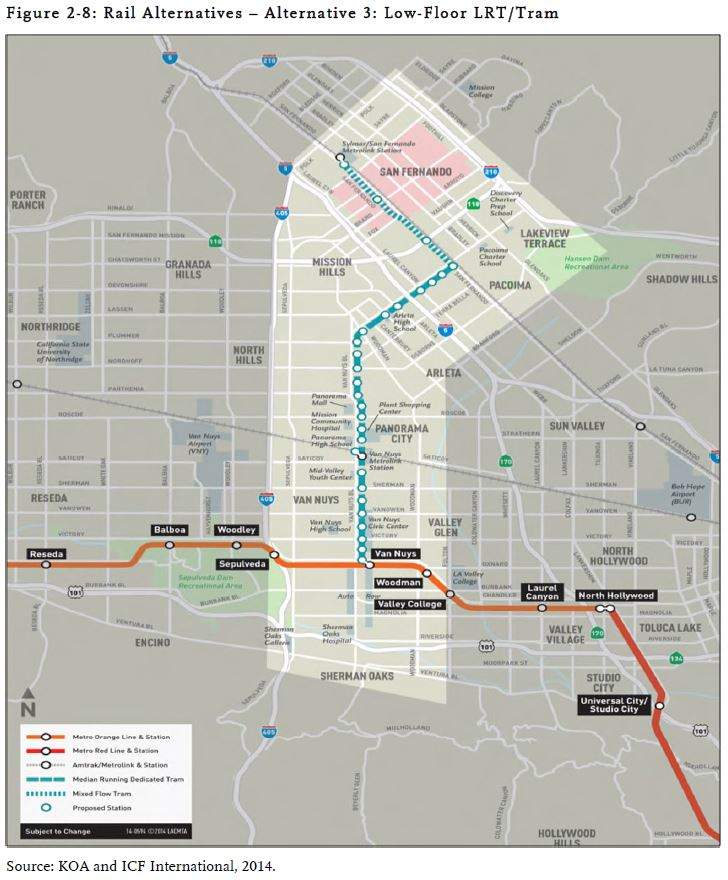
The low-floor light rail alternative would function similar to the streetcar system proposed in Downtown Los Angeles, and more akin to light rail along other segements.
Starting at the Sylmar/San Fernando Metrolink Station, vehicles would oeprate in a dedicated median guideway along San Fernando Road until reaching Wolfskill Street. From Wolfskill Street until Van Nuys Boulevard, mixed-traffic operations are proposed. At Van Nuys Boulevard, vehicles would turn south and run in a dedicated guideway until reaching the Van Nuys Orange Line Station.
As with most streetcar systems, frequent stops are proposed for the low-floor light rail alternative. A total of 28 stations are proposed between Sylmar and the Orange Line.
Trains would run at 4-minute intervals during peak hours, and 8-minute intervals during off-peak hours. Total travel times are estimated at 42 minutes from end-to-end.
Unlike the bus rapid transit options, the tram alternative necessitates the construction of a maintenance facility. Approximately 25-to-30 acres of land would be needed to construct this component of the project, with potential sites identified adjacent to the Orange Line, as well as at Van Nuys Boulevard's intersections with Keswick and Arminta Streets.
Construction of a tram is budgeted at $1.3 billion, with ridership projections estimating 35,800 daily riders by the year 2040.
LRT
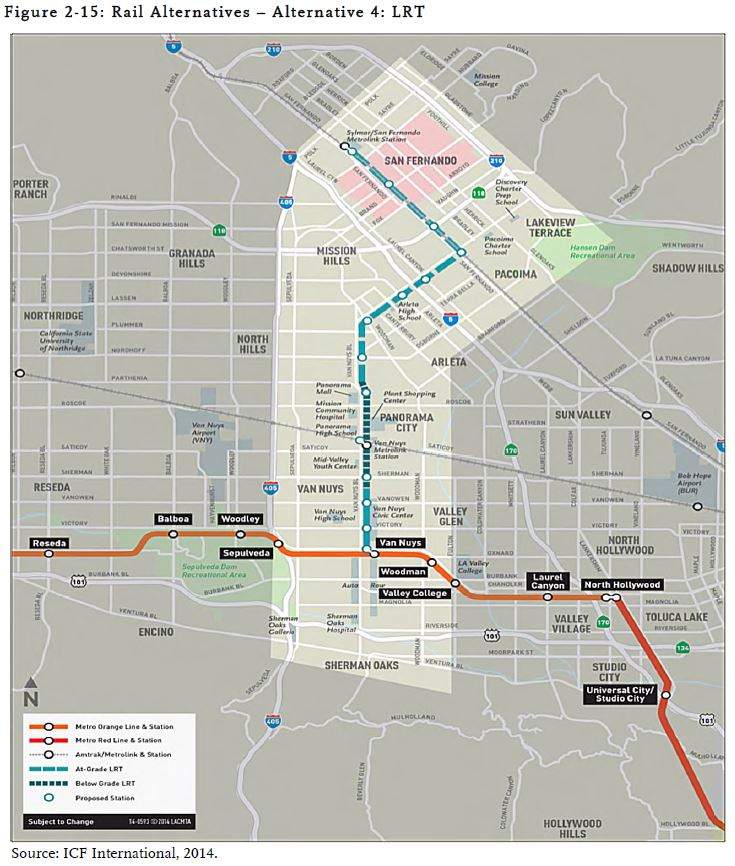
The light rail transit alternative calls for tracks to be located within the existing Antelope Valley Metrolink corridor, running from the Sylmar/San Fernando Station to Van Nuys Boulevard. Trains would then proceed south on Van Nuys Boulevard along a dedicated right-of-way towards Panorama City, where they would dive underground into a below-grade section between Parthenia Street and Sherman Way. After surfacing, service would continue at-grade in a dedicated right-of-way along Van Nuys Boulevard until terminating at the Orange Line.
The light rail alternatives proposes 14 stations, located at approximately 3/4-mile intervals across the route. This includes 11 at-grade stations, and three subway stations at Roscoe Boulevard, the Van Nuys Metrolink Station and Sherman Way.
Light rail vehicles would operate at 6-minute peak intervals, and 12-minute off-peak headways.
As with the low-floor tram alternative, a maintenance and operations facility would need to be construction. The same locations are proposed for the light rail alternative.
Light rail is the most expensive option under study, with an estimated cost of $2.67 to $2.79 billion. It is also has the highest ridership potential, with an estimated 47,400 daily passengers by the year 2040.
Evaluation
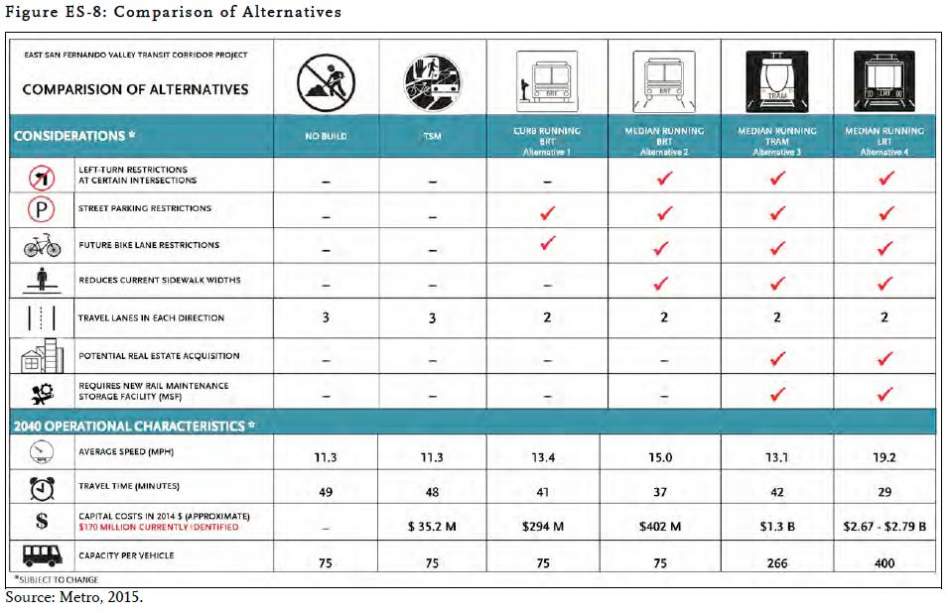
Metro is evaluating its alternatives under a criteria that includes regional connectivity, cost-effectiveness, environmental benefits and impacts, economic and land use impacts, community input, financial capability and mobility benefits. Performance of each option is detailed in the chart above.
A recommended alternative will be presented in the ESFVTC's final environmental impact report.
The project has $1.3-billion in dedicated local funding via the taxies levied under Measures R and M. Under the Measure M expenditure plan approved by L.A. County voters in November 2016, construction is expected to begin in 2021, with completion scheduled for 2027.
The ESFVTC will closely relate to other major infrastructure projects planned by Metro, including a Sepulveda Pass rail link and the conversion of the Orange Line busway to light rail.
- The East San Fernando Valley Transit Corridor Rendered (Urbanize LA)
- Draft Study Released for BRT or rail project... (The Source)




